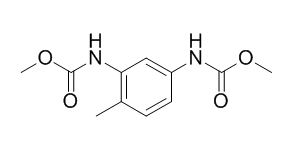Obtucarbamate A
Obtucarbamate A has antitussive activity, it exhibits significant inhibitory effect against neuroinflammation with the IC50 value of 10.57 uM .
Inquire / Order:
manager@chemfaces.com
Technical Inquiries:
service@chemfaces.com
Tel:
+86-27-84237783
Fax:
+86-27-84254680
Address:
1 Building, No. 83, CheCheng Rd., Wuhan Economic and Technological Development Zone, Wuhan, Hubei 430056, PRC
Providing storage is as stated on the product vial and the vial is kept tightly sealed, the product can be stored for up to
24 months(2-8C).
Wherever possible, you should prepare and use solutions on the same day. However, if you need to make up stock solutions in advance, we recommend that you store the solution as aliquots in tightly sealed vials at -20C. Generally, these will be useable for up to two weeks. Before use, and prior to opening the vial we recommend that you allow your product to equilibrate to room temperature for at least 1 hour.
Need more advice on solubility, usage and handling? Please email to: service@chemfaces.com
The packaging of the product may have turned upside down during transportation, resulting in the natural compounds adhering to the neck or cap of the vial. take the vial out of its packaging and gently shake to let the compounds fall to the bottom of the vial. for liquid products, centrifuge at 200-500 RPM to gather the liquid at the bottom of the vial. try to avoid loss or contamination during handling.
Agronomy2022, 12(10), 2426.
Molecules.2021, 26(3):695.
Molecules.2023, 28(19):6775.
Sci Rep.2023, 13(1):14594.
Chem Biodivers.2023, 20(12):e202301461.
Eur J Pharmacol.2024, 975:176644.
Biomedicine & Pharmacotherapy2020, 125:109950
Fitoterapia.2022, 105141.
Korean Herb. Med. Inf.2020, 8(2):243-254.
Front Microbiol.2021, 12:736780.
Related and Featured Products
Bioorg Med Chem Lett. 2017 Jan 15;27(2):248-253
Biotransformation of isofraxetin-6-O-β-d-glucopyranoside by Angelica sinensis (Oliv.) Diels callus.[Pubmed:
27919656]
Isofraxetin-6-O-β-d-glucopyranoside, identified from traditional medicinal herbal Xanthoceras sorbifolia Bunge, has been demonstrated to be a natural neuroinflammatory inhibitor. In order to obtain more derivatives with potential anti-neuroinflammatory effects, biotransformation was carried out.
METHODS AND RESULTS:
According to the characteristics of coumarin skeleton, suspension cultures of Angelica sinensis (Oliv.) Diels callus (A. sinensis callus) were employed because of the presence of diverse phenylpropanoids biosynthetic enzymes. As a result, 15 products were yielded from the suspension cultures, including a new coumarin: 8'-dehydroxymethyl cleomiscosin A (1), together with 14 known compounds. Their structures were elucidated by extensive spectroscopic analysis. Furthermore, the biotransformed pathways were discussed. Among them, compound 13 was transformed from isofraxetin-6-O-β-d-glucopyranoside, while compounds 1-6, 10-12, 14-15 were derived from the culture medium stimulated by the substrate. The biotransformation processes include hydroxylation, oxidation and esterification. Furthermore, their inhibitory effects on lipopolysaccharide (LPS)-activated nitric oxide (NO) production were evaluated in BV2 microglial cells.
It is worth noting that, 1, 1'-methanediylbis(4-methoxybenzene) (3), Obtucarbamate A (5), 2-nonyl-4-hydroxyquinoline N-oxide (10) and 1H-indole-3-carbaldehyde (11) exhibited significant inhibitory effect against neuroinflammation with IC50 values at 1.22, 10.57, 1.02 and 0.76μM respectively, much stronger than that of the positive control minocycline (IC50 35.82μM).
Zhongguo Zhong Yao Za Zhi. 2013 Dec;38(23):4099-103.
Antitussive constituents of Disporum cantoniense.[Pubmed:
24791497]
The antitussive activity assay for the root extraction of Disporum cantoniense was carried out with coughing mice induced by ammonia liquor.
METHODS AND RESULTS:
The results showed that the ethanol and water extractions of D. cantoniense possess strong antitussive activity, and the high dose of the former was better than positive control, and then the constituents of the ethanol extraction were separated and purified by various modern chromatographic techniques. Their structures were identified by physico-chemical properties and spectroscopic data. As a result, eight compounds were isolated and identified as stigmast-4-en-3-one(1), (22E, 24R)-ergosta-5, 7, 22-trien-3beta-ol(2), Obtucarbamate A(3), obtucarbamate B(4), neotigogenin(5), azo-2, 2'-bis[Z-(2,3-dihydroxy-4-methyl-5-methoxy) phenyl ethylene] (6),dimethyl {[carbonylbis (azanediyl)] bis( 2-methyl-5, 1-phenylene) j dicarbamate (7) , and quercetin-3-O-pB-D-glucopyranoside(8).
CONCLUSIONS:
All compounds were isolated from this plant for the first time, and the result of bioactivity-directed isolation showed that compounds 3, 4, and 6 had obvious effect on antitussive activity, and compound 6 had the same level as positive control.



